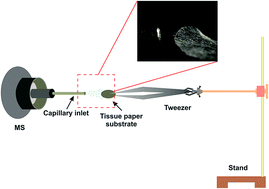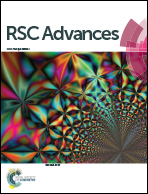Tissue paper assisted spray ionization mass spectrometry†
Abstract
Electrospray ionization mass spectrometry (ESI-MS) has been widely utilized in the analysis of analytes with a wide mass range. A metal ESI emitter, which is usually applied with a high voltage, is required in the setup of ESI-MS. Nevertheless, electrospray can be induced simply by the electric field provided by the mass spectrometer without applying electric contact on the ESI emitter. In this work, we demonstrate a simple and straightforward ionization technique for MS analysis by utilizing tissue paper as the sampling substrate and the ESI emitter. The fine fibers on the paper can work as ESI-like emitters to facilitate the generation of electrospray. When a small piece of tissue paper (diameter: ∼4 mm) loaded with a few microliters of the sample solution was positioned in the proximity of the inlet of a mass spectrometer applied with a high voltage, the analyte ions were readily generated and obtained by the mass spectrometer. Although no electric contact was made on the paper, the high voltage applied at the inlet of the mass spectrometer induced the formation of electrospray for MS analysis. This approach is applicable to the analysis of various samples including organic compounds, peptides, proteins, and complex samples. Additionally, tissue paper is flexible and can be used to sample trace amounts of samples from surface of solid objects such as drug tablets simply through wiping. The tissue with a trace amount of samples then can be readily placed close in front of the inlet of mass spectrometer followed by solvent deposition for MS analysis. Additionally, we also examined the feasibility of using this approach for quantitative MS analysis.


 Please wait while we load your content...
Please wait while we load your content...